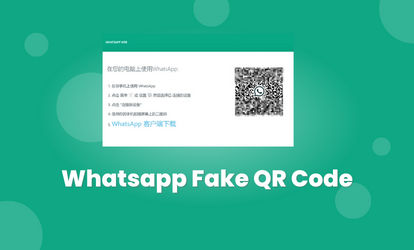Introduction
WhatsApp, a widely-used messaging application, is the latest platform to fall victim to a cunning cyberattack method, known as the WhatsApp QR Code Attack.
The Flow of WhatsApp QR Code Attack (Easy to Understand)
Attacker’s QR Session
The attacker initiates the attack by establishing a client QR session with the WhatsApp server.
Phishing Site Ads
To lure unsuspecting victims, the attacker adds phishing site advertisements to Google Search.
User Scans QR Code
Once a user, unaware of the malicious intent, scans the QR code using their WhatsApp mobile device.
Attacker Takes Control
With the QR session established, the attacker gains control of the victim’s WhatsApp account. The attacker can access messages, view contacts, and even send messages on behalf of the victim. This intrusion is often imperceptible to the user, as the attacker maintains a stealthy presence within the WhatsApp account; the attacker will try to archive the messages or deleted.
Data Intercept
As the attacker establishes control over the victim’s account, the WhatsApp server continues to deliver messages and data to the compromised account, which is now under the attacker’s command.
Conclusion
The WhatsApp QR Code Attack is a concerning breach of security that highlights the evolving tactics of cybercriminals. It exploits a feature designed to enhance user convenience and multi-device functionality.
WhatsApp, like other communication platforms, constantly works to bolster its security measures. However, the battle against determined attackers is ongoing. User awareness, best security practices, and vigilance in online interactions are key in safeguarding personal information and communication.
In the age of rapidly advancing technology, the WhatsApp QR Code Attack serves as a stark reminder that cybersecurity remains an essential concern, and both service providers and users must remain proactive in the face of emerging threats.
The Flow of WhatsApp QR Code Attack (Technical Part)
Cloning Real QR Codes
The attack begins with the attacker cloning a genuine QR code from official WhatsApp. This QR code is an essential element of WhatsApp’s multi-device feature.
Deceptive Websites
With the cloned QR code in hand, the attacker creates a fake WhatsApp website designed to mimic the appearance of the legitimate WhatsApp web interface.
WebSocket Connection
The fake WhatsApp website leverages a WebSocket connection (wss://w4.web.whatsapp.com/ws) to establish a connection with the official WhatsApp server.
QR Code Scanning
Unaware of the deception, the user scans the cloned QR code using their WhatsApp mobile application, believing they are linking to WhatsApp Web.
Unauthorized Data Sharing
The mobile device communicates with the WhatsApp server, sharing the user’s phone number (XXXX) and authentication credentials (YYYYY).
Confirmation
The WhatsApp server confirms the WebSocket connection associated with the QR code, believing it is in communication with an authentic WhatsApp Web session. This provides the attacker with a secure channel for access user data.
Resource Requests
The fake WhatsApp website, in response to WebSocket instructions, sends corresponding GET requests to the WhatsApp server, fetching essential resources such as thumbnails and other media.
Data Snoop
As the communication channel is secured, the attacker begins to view all messages from the user account. This can include the user profile information and ongoing conversations.
Gaining SessionID
The attacker ultimately gains access to the victim’s SessionID, a critical element in maintaining control of the victim’s account. This allows the attacker to manipulate the victim’s WhatsApp account and continue data snooping.
Solution
In the face of ever-evolving threats like the WhatsApp QR Code Attack, innovative solutions are crucial to protect users from phishing attacks.
The Power of AI PhishNet
Zero-Day Attack Detection:
AI PhishNet excels at identifying zero-day phishing attacks, which are previously unknown and lack specific signatures.
Real-time Monitoring:
AI PhishNet operates in real-time, continuously analyzing user interactions with websites and services. It promptly raises alerts or blocks access when it detects suspicious activity, ensuring immediate intervention.
Pattern Recognition:
The AI system from Prosfinity utilizes pattern recognition to identify potential phishing sites and tactics.
Multi-Layered Protection:
AI PhishNet is not limited to a single method of detection. It combines several AI techniques to create a multi-layered defense, boosting accuracy and reducing false positives.
The Solution for WhatsApp Users
AI PhishNet is available as a Chrome extension and can be seamlessly integrated into WhatsApp’s security framework to protect users from deceptive attacks. The free version of this extension is accessible to personal users without requiring any login or subscription fees.
Key Benefits:
Real-time Protection:
AI PhishNet instantly identifies and blocks access to deceptive websites, ensuring users are shielded from inadvertently scanning fake QR codes.
Continuous Adaptation:
As threats like the WhatsApp QR Code Attack evolve, AI PhishNet adapts to recognize new attack methods and behavioral patterns.
Low False Positives:
Its AI multi-layered approach minimizes the chances of false positives, ensuring legitimate user interactions are not unnecessarily blocked.
Empower Users:
With AI PhishNet bolstering WhatsApp’s security, users gain confidence in the platform’s ability to fend off attacks, allowing them to interact with greater peace of mind.


